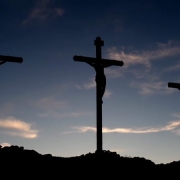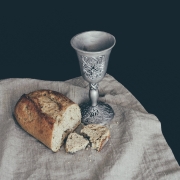“It is Finished.”
An eerie gloom fell over the area and the bystanders. As the hours went by, Jesus’ breath became more and more labored. Beyond his severe physical pain, Jesus began to feel the indescribably intense pain of all of humankind’s sins being borne by him. Sins of a mundane nature and sins of great depravity became Jesus’ to absorb. Jesus was now the sacrificial lamb, absorbing all of humankind’s sin.
Finally, in his full humanity, Jesus cried out, “My God, my God, why have you forsaken me?” (Mk. [15:34]).
Those who were standing near heard this and said, “Listen, he is calling Elijah” (Mk. [15:35]). Those standing by missed that Jesus wasn’t crying out to the prophet Elijah, but Eloi. Eloi is another expression of God and literally means, in Hebrew, “God of me.” An awful darkness fell over the area as Jesus hung, suffering.
Jesus’ human body was shutting down. He was suffocating and quickly losing body fluids. Each of his major organs was failing. His heart and lungs were stiffening from the loss of blood. His human end was near.
It was now mid-afternoon; knowing this, the soldiers did not want to leave Jesus on the cross with the approaching Sabbath. They discussed breaking his legs to hasten his death. As they were discussing this, Jesus said, “It is finished” (Jn. [19:30]). Then, he released one last groan and his human form died.
When Jesus said, “It is finished,” he was declaring he had completed God’s will. His physical pain and the absorption of all human sin was over. He had finished the brutal part of redemption. Now only his wonderous divinity was left. He had come to serve humanity as human and had finished his difficult task.
At the same time, the curtain in the temple was torn in two. A Roman soldier who stood nearby and watched the whole crucifixion said, “Surely this man was the Son of God!” (Mk. [15:39]).
The tearing of the curtain, which separated the sacred temple room of the Holy of Holies, was symbolic of the new life Jesus had just created for the world. No longer was the temple in Jerusalem the way to God. But through faith in the blood Jesus had shed for humankind, all people could find God. Essentially, God had moved from the temple.




